Pest control
Download in pdf
The term “pests” refers to animals, insects and diseases that attack crops.
Methodology
plants in each plot at least once a week and every day if pests appear.
at the slightest anomaly.
the cause (termites, fungus, irrigation, wind etc.).
by calculating the percentage of affected plants whose biomass production is seriously reduced
seed suitability, biodiversity, crop associations, crop rotation, use of fully mature compost, mulching, adequate watering, non-infested equipment etc.
that seems to be spreading, immediately remove parts of plants or entire affected plants from the field and burn. Do not compost!
Plant protection products are PROHIBITED in organic farming! Plant growth regulators are prohibited too.
Agrochemicals used to promote the growth of medicinal plants or to protect them must be applied in minimal quantities and only if there is no other option. Integrated pest management methods for crop pests, i.e. favouring natural mechanisms and the use of pesticides, should only be used if economically justified and safe for human health and the environment! [1]
For more information on integrated pest management and different control methods, refer to the AGRISUD Guide [2] p 145 to 148.
has significant impact, causes real losses and it is cheaper to apply a plant protection product.
for consumer crops and in compliance with the regulatory requirements of the country of production and consumption of the end product [3].
or package leaflet of the plant protection product used, including the pre-harvest interval (PHI), i.e. the minimum interval between treatment and harvest.
.
Applying plant protection products may only be performed by a qualified person with adequate personal protective equipment (PPE), i.e. as recommended on the label, Material Safety Data Sheet (MSDS) or Information Sheet.
This may include: pesticide-proof mask, coveralls, long trousers, long-sleeved shirt, gloves and shoes ... [1].
All applications of plant protection products (including homemade preparations) must be documented in the batch and cultivation record !
Practical advice
Numerous expert guides propose natural pest control methods.
Some plants such as neem are particularly useful to include in a medicinal garden with Artemisia.
For more information on this subject, see the AGRISUD Guide [2] p 149 to 154.
A field that supports biodiversity has a real beneficial effect on crops by controlling the overall impact of pests.
Planting Artemisia annua and Artemisia afra in new growing areas leads to the appearance of all kinds of attacks that are still unknown or not very well documented in the literature.
Below is a non-exhaustive list of pests observed on Artemisia in the Houses of Artemisia network together with feedback on tested control methods.

These white worms devour roots and thus halt the growth of plants.
It is important to sterilise the soil used for sowing and protect the seedbed as indicated in File Sowing.
Reducing watering and aerating the soil for new seedbeds has helped to combat the problem in Gabon.

Artemisia annua seedlings and young plants are sometimes ravaged by molluscs (snails, slugs etc.).
Physical protection, such as a mosquito net, is effective.
Some members of the network use ashes, coffee grounds or salt powder to build a natural firewall.

Wasps have been reported to cut Artemisia leaves in the seedbed.
Physical protection and using neem is said to be effective.
NB: Building a slug trap with beer is very simple and effective. Take a bowl and dig a hole. Place the bowl so that the rim is flush with the earth and fill with beer. Slugs love the smell, dive in and drown. If it rains, cover the trap.
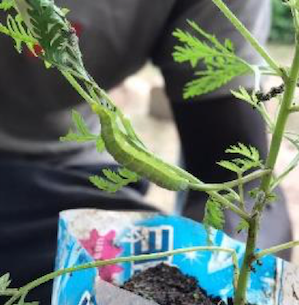
Some caterpillars can impact considerably on the growth of young Artemisia seedlings.
In Cameroon, a simple maceration of neem leaves (left to steep 24 hours in water) sprayed on young seedlings stopped caterpillar attacks.

Artemisia annua et afra are sometimes attacked by termites that gnaw at the base of the plant and cause it to die quickly.
Often, the impact across the whole plot is not so alarming. Especially if only a base branch is attacked.

In many places, ants can be a problem at the sowing or cultivation site.
According to feedback we have received, neem is very effective in the fight against ants.
Termites:
To prevent termites, it is important to avoid using wood (eg. for marking transplanting) or certain mulching matter that could attract termites.
If damage is significant, burying pieces of wood in the ground away from crops seems to keep termites away from Artemisia. Adding ash to sowing soil instead of sand, to the base of plants or in the bottom of transplanting holes can be very effective. Crush dried eggshells and put them at the feet of the plants, and black soap too, according to feedback from the network. We have also heard of the beneficial effect of hot peppers, garlic and mint.
The use of neem leaves or cake in mulch is also interesting [2].
A row of vetiver (Vetiveria zizanoides) can also be planted between rows of Artemisia.
This grass has a repellent effect against ants and termites.
Ants:
Homemade neem extract is very easy to make provided one has access to leaves of the tree :
- Crush 3 kg of leaves with a mortar.
- Soak in 10 litres of water for 6 to 12 hours until the water turns greenish.
- Add soapy water to bring the mixture up to 30 litres.
- Spray the mixture of macerated neem + soapy water at a rate of 3 litres per 10 m².
- Repeat after 10 days if necessary.
It is also possible to buy neem oil commercially :
- Follow instructions to dilute in hot water.
- A small amount of soap can be added (5g for about 10 litres).
- Shake well to obtain a uniform mixture.
- Spray directly and shake from time to time.
The IER (Rural Economy Institute) in Mali noted a phytotoxic effect of neem oil on young Artemisia annua seedlings.
Neem is an effective insecticide against many insects: caterpillars, aphids, beetle larvae, leaf miner flies, leafhoppers etc. [2]
Wood ash can be used against ants, aphids and flies:
Mix ½ cup ashes + ½ cup lime + 4 L water. Leave to stand for a while, filter and spray on plants.
Another suggested method is to mix 1 tablespoon of ashes with 1 L water and leave overnight. Then filter, add one cup fermented milk per litre, dilute the mixture in 3 times its volume of water and spray on plants.
NB: It is always advisable to check the efficacy or toxicity of the mixture on a few plants before treating all affected plants. [5]
As a preventive measure, unmacerated neem leaves or neem cakes can be used directly to combat insect infestation in the soil. Add to soil or mulch, use as green manure in seedbeds or mix into compost. [2]
A row of vetiver (Vetiveria zizanoides) can also be planted between rows of Artemisia.
This grass has a repellent effect against ants and termites.
Numerous crop associations have been proven effective against insects (pepper, tobacco, garlic etc.).
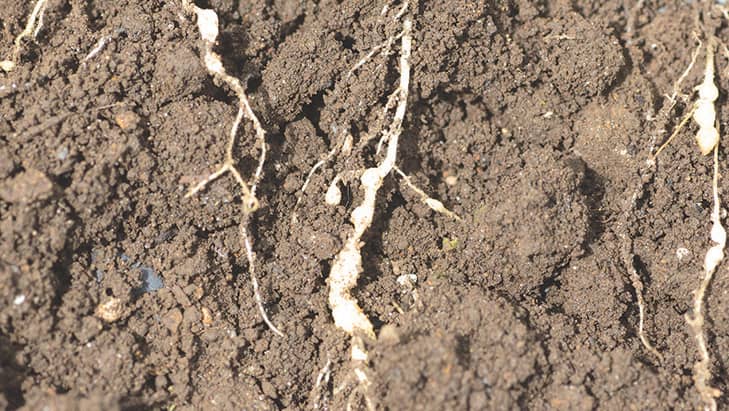
Irreversible wilting and plant death can be caused by nematodes, a type of worm found in the soil.
These worms can be identified by uprooting dead plants to check for blisters on the roots.
If the impact is significant, treatment with neem or Tithonia can be useful (see Practical Guide to Agroecological Market Gardening in Brazzaville [4]).
A garlic solution (3 crushed cloves of garlic in 1 L water) has been shown to be effective at a dosage of 10 ml per Artemisia plant. Reapply once a fortnight for 2 months.
Also consider crop rotations and nematicidal plants : http://ephytia.inra.fr/fr/C/
20121/Hypp-encyclopedie-en-protection-des-plantes-Les-plantes-nematicides

In Côte d'Ivoire, aphids have been found on Artemisia afra stems (see photo). They are responsible for the transmission of viral diseases to plants.
It has been observed that leaves crinkle, curl and narrow at the base (see photo).
Neem oil mixed with black soap has proven effective. It should be noted, however, that the IER (Rural Economy Institute) in Mali reported that neem oil was phytotoxic to young Artemisia annua seedlings.
See above for an ash-based preparation against ants, aphids and flies [5].
Artemisia annua is also attacked by aphids. The same treatments are recommended.

Woolly aphids have previously been observed on Artemisia annua. This parasitic insect is characterised by its small size and a whitish waxy coating. On observation, it looks like it is covered in cotton down (do not confuse with mealy bugs, see below).
Leaves curl and stems are covered with a woolly white felt.
Once the plant is impacted, growth is stunted and fungus and diseases can appear.
Start treatment as soon as woolly aphids appear as they multiply extremely quickly (a female can lay up to 100 larvae and generate 10 generations in 6 months).
A black soap-based preparation will eliminate woolly aphids. Mix 150 g of black soap with 1.5 L methylated spirits (household cleaning alcohol) and 10 L water and spray the plants.
Sow nasturtiums around the plants as a preventive measure.

A case of leaf miner fly on Artemisia annua seedlings has been reported to us. Caterpillars dig galleries by eating the leaves, causing white lines to appear on the surface (see photo).
After removing affected leaves to limit the infestation, it may help to apply a garlic maceration. See above for an ash-based preparation against ants, aphids and flies [5].
Placing a protective cover over seedbeds can help if attacks are recurrent.

Several cases of mealybug damage have been observed on Artemisia annua.
In Senegal, wilting of adult plants was the first visible symptom. Pink mealybugs, white wax and ants were observed on the roots. Mealy bugs form colonies just beneath ground level and ants feed on the honeydew in exchange for protection.
As the impact was minimal, removing affected plants from the field and burning them was sufficient.
In more severe cases, a preparation based on neem, tobacco or Tithonia can be effective. See the Practical Guide of the Agroecological Market Gardening in Brazzaville [4].

At the larval stage, this leafhopper produces white foam as a defence system against pests. It sucks the sap from the plant.
According to feedback from our network, Artemisia plants are not overly affected. There is no need to worry too much because only the leaf on which the larva is laid is damaged and this can easily be removed by hand.
In several countries, white mealy bugs have been observed on the aerial part of Artemisia annua.
In Congo Brazzaville, generous watering of foliage helped to get rid of them. However, this method is not always effective in getting rid of eggs and larvae attached to the underside of leaves.
In severe cases, neem, tobacco or Tithonia preparations can be effective. (See the Practical Guide of the Agroecological Market Gardening in Brazzaville [4]).
The IER (Rural Economy Institute) in Mali reported that neem oil was phytotoxic to young Artemisia annua seedlings.
Alternative solutions to try are: one teaspoon of liquid black soap in 1.5 L of water or equal proportions of soap and oil diluted at a ratio of one teaspoon (= 5 ml) to 150 ml of water (source: S. K. K. (https://jardinage.ooreka.fr/fiche/voir/267948/lutter-contre-les-cochenilles)
Ashes, basil, garlic and nettles can be used for prevention. See the Practical Guide of the Agroecological Market Gardening in Brazzaville [4].

These insect pests appear seasonally and eat Artemisia plants at any stage but seedlings and seedbeds are more vulnerable.
Neem leaf powder (dried and ground leaves) has shown a conclusive repellent effect in Côte d’Ivoire.
Songhai Centre in Porto Novo reported an effective method of treatment for locusts in Togo and Benin (particularly stinking locusts). Collect 10 locusts, crush and mix into 5 L water, then spray the solution on the plants.
Chickens and ducks are formidable predators for locusts but they should not eat Artemisia! Any poultry that does not eat vegetables and prefers insects to grass is a useful control method.

In Côte d'Ivoire and Congo Brazzaville, crickets are said to cut branches off adult plants (Artemisia annua and afra) and bury them in the ground.
Attacks are reported to be particularly frequent at night during the dry season.
However, the impact has not been significant enough for this problem to be addressed within the Houses of Artemisia network.
Nonetheless, if there is sufficient cause for concern, the simplest control method is to catch the crickets by hand or to set traps. A shallow bowl half-filled with water and a few spoonfuls of molasses can be used to bait them. In dry weather, another method is to dig a small furrow between infested crops, water abundantly and cover with a board. Crickets sheltering in the furrow can then be collected once or twice a day.
Diatomaceous earth and certain crop associations (coriander, beans, pulses, cloves, garlic and peas) can also be effective.

Damage to Artemisia can be of great concern because the stems are often eaten directly with the leaves. The entire plant can be affected if it is still young. Fortunately, plants are very resistant to cutting and their growth is not too impacted if the central stem remains intact and attacks are not repeated.
The most effective means of protection against damage from wandering animals is to fence off the cultivation site with high, compact barriers to prevent animals from entering.
Note that the Food and Agriculture Organisation of the United Nations (FAO) considers that consuming crickets would be a great way to fight malnutrition since it provides high quality protein.
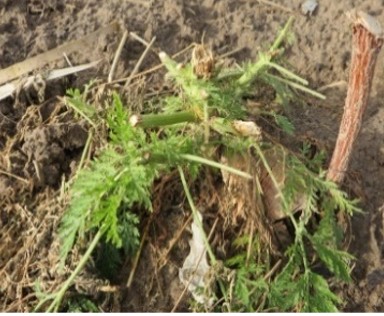
These rodents cut leaves, or sometimes whole stems of Artemisia annua, and leave them on the ground. They prefer tender shoots, which explains why attacks only occur in the first month after transplanting.
Damage to young seedlings is a concern since it hinders plant growth when the central stem is cut.
However, the impact is minor when only a few leaves or secondary stems are cut. This is due to the ability of Artemisia to grow better after cutting.

Seedbeds and freshly transplanted seedlings are sometimes attacked by birds. They can be protected by covering with branches.

Although it has not yet been observed in the network, we have learnt of an emerging virus threatening Artemisia annua. This virus with spherical particles is said to cause plants to dry out and stunt growth. (https://www.admin.ch/gov/fr/accueil/documentation/communiques.msg-id 27951.html?fbclid=IwAR0tFpV6Ew5HzQ1KjiSpPr9pVr4YCQU2bWayu5lz16EfXXvzhYOAbttDxl0 )
NB: Crop diversification is a way to keep rabbits away from Artemisia which they eat as a last resort.
If damage is significant, using a shotgun seems to be the most effective method of pest control. Unlike rats, rabbits are too wary to enter a cage, no matter what bait is placed.
Placing blue rags soaked in gasoline or hanging noise-producing cassette wire on the windward side does not appear to scare them away. Carefully camouflaged traps placed in the impacted area have little effect.
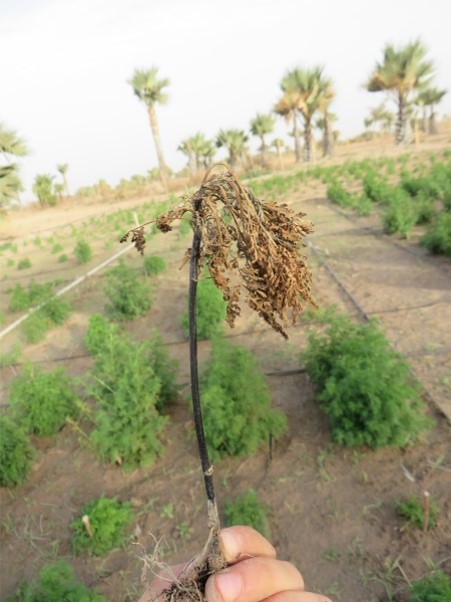
If the seedbed is over-watered, seedlings can be attacked just before or a few days after germination by pathogenic fungi that cause damping off.
If they have sprouted, the seedlings are weakened, soften and die quickly.
Conditions favourable to this disease are humidity, cold (T<10°C) and stagnant water.
Sterilisation of the sowing soil and careful watering to ensure soil is moist but not soaked help to avoid this fungal disease.

A pathogenic fungus of the genus Rhizoctonia was noted in several countries (Senegal, Benin etc.) in 2017. It is of concern, especially when plants are grown in high density and in a humid atmosphere.
The first symptoms of this fungal disease on Artemisia annua and afra are yellowing and/or browning of leaf tips followed by browning of stems at the base. Thereafter, a black line going up the central stem eventually extends to the whole plant and leaves become necrotic (die).
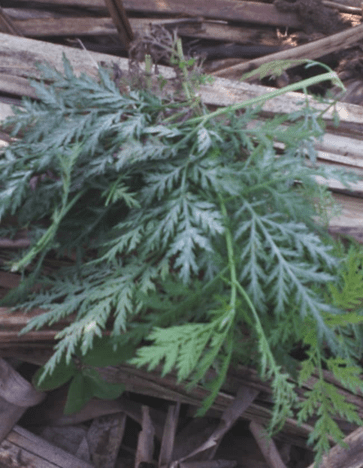
This pathogenic fungus has been recorded on Artemisia annua in Rwanda.
A white colour slowly develops, forming a sort of white powder on the leaves which then spreads to the whole plant within a few days.
As with most fungi, the cause seems to be excess water that should be dealt with as soon as possible (see above for recommendations against the pathogenic fungus of the genus Rhizoctonia).
Treatment with 1-4% bicarbonate of soda (10-40 g of bicarbonate in 1 L water) seems to work. Spray affected plants once a week until symptoms disappear.
When Rhizoctonia spp. is present in the environment, it is important to control the water supply to avoid the presence of stagnant water around the roots. Mulching and drainage channels are useful to ensure that the soil is not too wet on the surface.
As a preventive measure, ensure there is sufficient aeration between plants to avoid humidity which is conducive to development of the fungi.
Remove all parts of plants (eg. blackened main stem), or entire plants if severely impacted, from the field as soon as the fungi is identified.
Do likewise for any other affected plants around the growing site. Burn all contaminated plants. Do not compost.
Repeat this procedure every day to limit the spread!
Cutting can promote healthy regeneration of foliage.
Rhizoctonia spp. is easily introduced into the crop by manual cultivation practices, using unsterilised tools or pots, or transplanting young plants with contaminated soil. Therefore, care should be taken to sterilise seedbed soil and to disinfect tools that come into contact with contaminated plants or soil.
If the spread of the disease becomes a concern, there are many natural antifungal recipes which can be used immediately after removal of any affected parts or plants.
In Cameroon, a preparation based on wood ash has been proven effective. Mix thoroughly 1 L wood ash with 10 to 15 L water, filter and sprinkle on diseased plants using a watering can or spray.
This treatment has been shown to be even more effective in combination with a papaya and basil based preparation. Garlic or nettle liquid manure also works against soil-borne pathogenic fungi. For full recipes see the Practical Guide of the Agroecological Market Gardening in Brazzaville [4].
In Ghana, a 2-week application of a lemon, neem oil and ash solution was effective against Rhizoctonia spp.
Organically approved fungicide can be used if necessary. Treatment with a formula based on the antagonistic fungus of the genus Trichoderma is an option, but has not been tried by the Houses of Artemisia network.
This pathogen is persistent in the upper part of the soil. Following a major attack, it is useful to sterilise the soil or change cultivation site for the following year. To sterilise the soil, hoe then moisten the soil surface well, cover with a black tarpaulin and leave for at least 1 month in the sun

This is due to excess fertiliser which has “scorched” the Artemisia.
IMPORTANT: Use only mature compost. Do not use uncomposted chicken manure !

This is simply due to ageing of the stems (leaf senescence).
The lower leaves of Artemisia afra tend to become necrotic, in same way as for Artemisia annua.
The dried ("burnt") leaves on the stem are dead, without active molecules and cannot be used for herbal tea. Since leaves lose their beneficial properties as they age, we recommend harvesting lower leaves of plants before they turn yellow.
Feedback from our network suggests that this phenomenon is accentuated when the plant is not regularly pruned.

Pest attacks can trigger the appearance of flower buds, signifying the end of the vegetative phase and thus halting growth of Artemisia. If only one part of the plant goes into flower, removing it can allow the plant to resume growth if the source of stress is controlled.
To prevent early flowering, it is important to protect plants from any source of stress (water, wind, etc.). To protect from wind, consider wind-breaking trees and hedges.
Protective structures against wind, rain or direct sun are sometimes necessary.
NB for « Burns » on lower branches of Artemisia afra
If the ground is wet, check that the roots do not turn black. This could point to possible attack by the fungus Rhizoctonia spp (see above).
In Gabon, removing and burning all dried leaves and pruning affected Artemisia afra plants has proven extremely effective (see File – Harvesting Artemisia afa).
Pruning rejuvenated plants, produced new leaves full of beneficial properties at the base and stimulated growth.
(photos on the right).
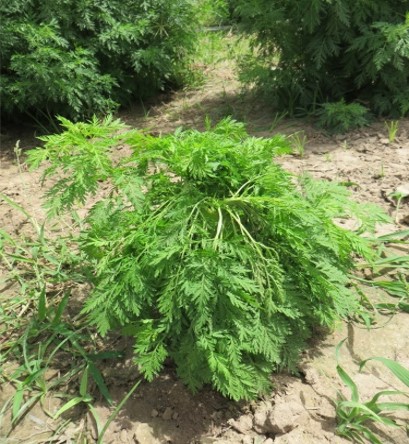
Sometimes, a few Artemisia annua plants may exhibit abnormal appearance and growth.
For example, they can be much smaller and less productive than normal because their central stem thickens and twists (see photo).
This phenotype may be the result of an undetermined external factor. However, it is probably simply the result of the significant genetic variability of the seeds distributed within the Houses of Artemisia network. This variability is of interest since it is the basis for adaptation of Artemisia to different growing conditions.
Collecting seeds from the most adapted and productive plants should be enough to overcome this problem by mass selection.

This seems to be caused by a mutation or an albino gene due to genetic variability.
After 1 or 2 weeks, white seedlings die. They stop growing and gradually degenerate since they cannot photosynthesise.
Bibliography :
1. World Health Organisation. WHO Guidelines on good agricultural and collection practices (GACP) for medicinal plants. 2003. Available at: https://www.who.int/medicines/publications/traditional/gacp2004/en/
2. AGRISUD. L’agroécologie en pratiques – GUIDE édition 2020. 2020. (Practical agroecology). Available at: http://www.agrisud.org/wp-content/uploads/2020/04/Agrisud_Guide_Agroecologie_2020.pdf
3. World Health Organisation. WHO monograph on good agricultural and collection practices (GACP) for Artemisia annua L. 2006.Available at: http://www.who.int/malaria/publications/atoz/9241594438/en/
4. ESSOR, Guide pratique du maraîcher agroécologique de Brazzaville. 2018. (Practical Guide to Agroecological Market Gardening in Brazzaville). Available at: https://www.essor-ong.org/wp-content/uploads/2020/04/2018_Guide_pratique_du_maraicher_agroecologique_de_Brazzaville_-_Biopreparations-FR.pdf
5. Insecticides – fongicides, des méthodes naturelles pour protéger les plantes contre les ravageurs. (Insecticides – fungicides, natural methods to protect plants against pests). Article published by Agriculture Agrobusiness, 28 January 2018. Available at: http://immersion-entreprise.com/insecticides-fongicides-des-methodes-naturelles-pour-proteger-les-plantes-contre-les-ravageurs/?fbclid=IwAR0j_8wEq0ZicV258hPsPiXKAdYlD2gTbJOU8NWdve03A7U1317VR46n3jg










